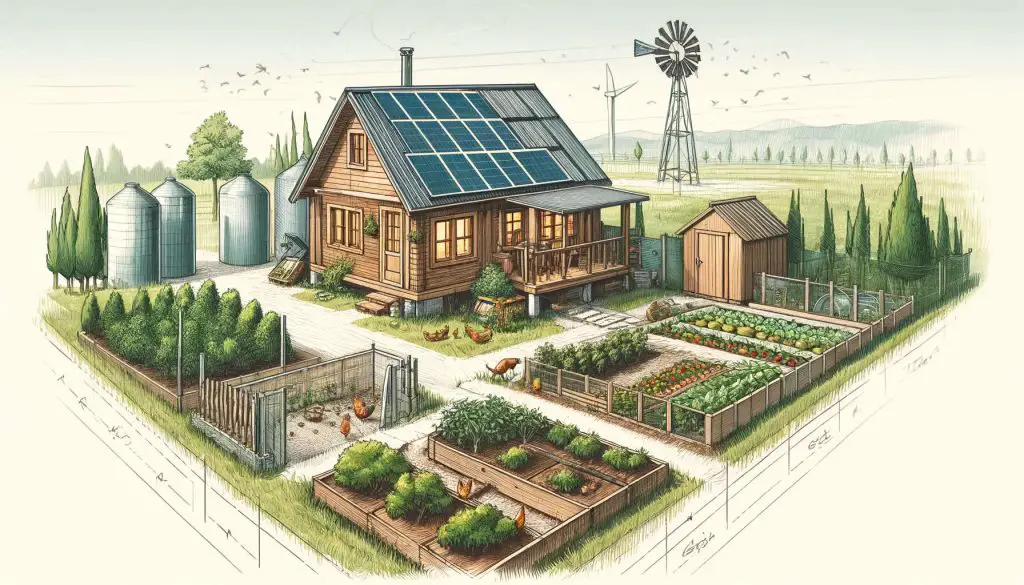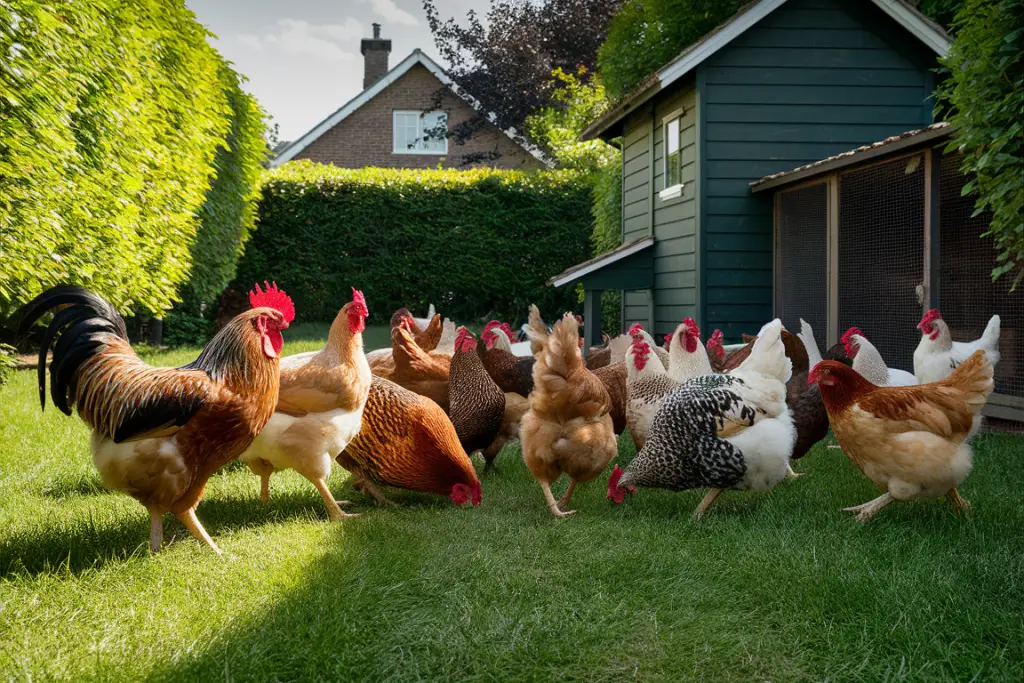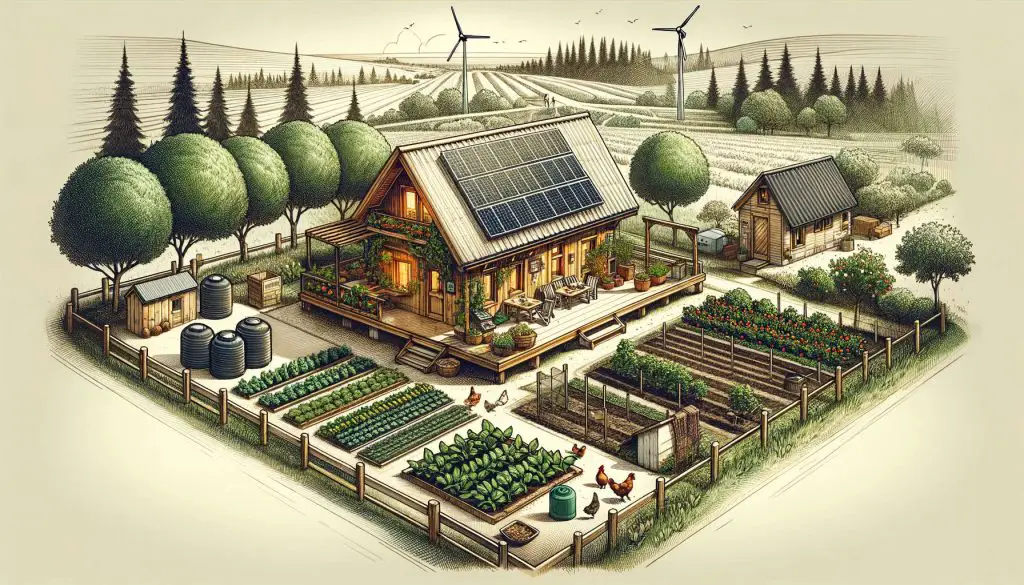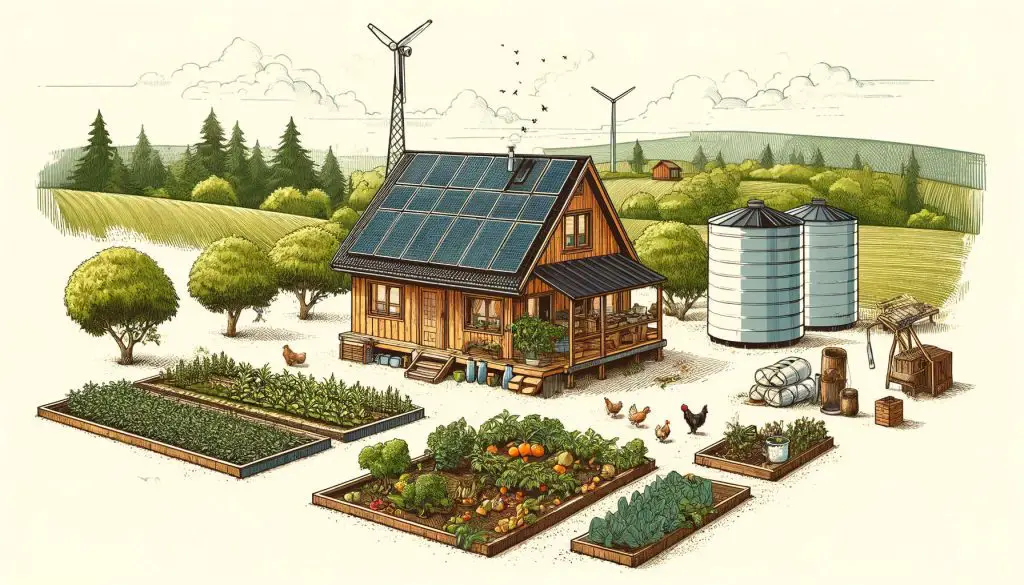Ditch the Grocery Store (Maybe): Designing Your Dream Homestead
Have you ever dreamed of biting into a juicy tomato still warm from the vine, or scrambling fresh eggs laid by your own happy hens? Maybe the idea of a simpler life, closer to the land, has been tugging at you. If so, then homesteading might be for you!
It’s not about going off the grid completely (although that’s an option!), but rather creating a lifestyle where you can produce more of your own food, water, and maybe even energy. It’s about self-reliance, fresher ingredients, and a deeper connection to where your food comes from. And guess what? You don’t need a giant farm or fancy equipment to get started.
To approach homesteading properly we need to break down the core features of a self-sustaining homestead, explore different approaches to fit your needs, and answer some key questions before you take the plunge. So, whether you’re a weekend warrior or aiming for full-on self-sufficiency, this article will equip you with the knowledge to design your dream homestead, one step at a a time.
Self-Sustaining Homesteads

The dream of living off-grid and self-sufficiently is becoming a reality for many. It’s a lifestyle that promises independence, environmental stewardship, and a deeper connection with the land. To embark on this journey, it’s crucial to understand what a self-sustaining homestead truly entails and the numerous benefits it offers.
A self-sustaining homestead is designed to operate independently of external utilities and services. This means generating your own power, managing your water supply, growing your own food, and handling waste effectively. The goal is to create a harmonious system where all elements support and enhance each other, reducing reliance on outside resources.
Living this way brings numerous advantages. It significantly lowers living costs by eliminating utility bills and reducing grocery expenses through homegrown produce. Additionally, it minimizes environmental impact, contributing to a more sustainable planet. The sense of independence and self-reliance is unmatched, offering a fulfilling and rewarding lifestyle.
My own journey into homesteading began with a desire for a simpler, more sustainable life. The process of building a self-sustaining homestead has been incredibly educational and satisfying. Through this article, I aim to share insights and tips that can help you take your first steps toward this rewarding lifestyle.
Energy Independence

Achieving energy independence is a cornerstone of a self-sustaining homestead. Harnessing renewable energy sources not only reduces your environmental footprint but also provides a reliable and cost-effective power supply. Understanding the options and practical steps involved can help you make informed decisions for your homestead.
Renewable energy sources, such as solar panels and wind turbines, are essential for generating your own electricity. Solar panels, for example, convert sunlight into electricity, providing a clean and abundant energy source. Wind turbines, on the other hand, harness the power of the wind to generate electricity, especially useful in areas with consistent wind patterns.
Setting up these systems requires careful planning and consideration of initial costs, maintenance, and efficiency. Solar panels need to be placed where they receive maximum sunlight throughout the day. Wind turbines should be installed in open areas where wind flow is unobstructed. Both systems can be scaled according to your energy needs, ensuring you have a reliable power supply.
Many homesteaders have successfully implemented renewable energy solutions, significantly lowering their energy bills and reducing their reliance on external power sources. For instance, a family in rural Texas installed a combination of solar panels and a wind turbine, which now covers all their electricity needs. Their experience highlights the feasibility and benefits of investing in renewable energy for a self-sustaining homestead.
Transitioning to renewable energy not only supports a sustainable lifestyle but also offers long-term financial savings. Embracing these technologies can lead to greater independence and a cleaner, greener way of living.
Water Management

Effective water management is crucial for any self-sustaining homestead. Ensuring a reliable water supply and using it efficiently can make a significant difference in achieving true independence. Implementing practical solutions for collecting, conserving, and reusing water is essential.
Rainwater harvesting is a key method for managing water resources. Collecting rainwater from roofs and storing it in tanks provides a valuable supply for various uses around the homestead. Simple systems, such as gutters and downspouts leading to storage tanks, can capture and store large amounts of rainwater. It’s a sustainable and cost-effective way to ensure water availability.
Conserving water through mindful usage and efficient fixtures helps in maintaining a balanced water supply. Installing low-flow fixtures in kitchens and bathrooms reduces water consumption without compromising functionality. Additionally, utilizing greywater systems allows you to reuse water from sinks, showers, and washing machines for irrigation purposes. These systems can be simple to set up and significantly reduce the need for fresh water.
A well-managed water system can make a homestead resilient and self-sufficient. For example, a couple in Oregon set up a comprehensive rainwater harvesting and greywater system, enabling them to live comfortably without relying on municipal water supplies. Their system captures and stores enough water to meet all their needs, demonstrating the effectiveness of these methods.
Integrating these water management strategies into your homestead design ensures a steady and sustainable water supply. Embracing these practices not only supports self-sufficiency but also contributes to a more environmentally friendly lifestyle.
Food Production

Growing your own food is a fundamental aspect of a self-sustaining homestead. Not only does it provide a reliable and fresh food supply, but it also connects you more deeply with the land. Implementing effective gardening and farming practices can make your homestead truly self-reliant.
Vegetable gardens are an excellent starting point for home food production. Selecting a variety of vegetables that grow well in your climate ensures a steady supply of fresh produce. Raised beds or traditional garden plots can be used, depending on your soil quality and space availability. Regularly rotating crops helps maintain soil health and prevents pest buildup.
Fruit trees and bushes add another layer of food security. Planting apple, pear, and berry bushes can provide an abundance of fruit throughout the growing season. These plants often require less maintenance than annual crops and can yield fruit for many years.
Livestock such as chickens, goats, and rabbits can further enhance your homestead’s food production. Chickens provide fresh eggs, goats offer milk and meat, and rabbits are a source of high-quality protein. Properly housing and caring for these animals ensures their health and productivity.
Permaculture principles play a vital role in creating a sustainable food system. Designing your garden to mimic natural ecosystems promotes biodiversity and resilience. Companion planting, where certain plants are grown together for mutual benefit, can improve yields and reduce pests.
For instance, a family in Vermont transformed their homestead into a thriving food hub using permaculture techniques. They grow a variety of vegetables, fruits, and herbs, and keep chickens and goats. Their efforts not only meet their food needs but also create a beautiful and productive landscape.
Implementing these food production strategies allows you to enjoy fresh, homegrown produce year-round. It enhances your self-sufficiency and fosters a deeper connection with the natural world.
Waste Management

Handling waste effectively is a crucial part of maintaining a self-sustaining homestead. Proper waste management not only reduces environmental impact but also contributes to a healthier and more efficient living space. Adopting sustainable practices for dealing with waste can significantly enhance your homesteading experience.
Composting organic waste is one of the most effective ways to manage kitchen scraps and yard debris. Composting turns these materials into nutrient-rich soil that can be used to enrich your garden. Setting up a composting system can be as simple as creating a pile in a designated area or using a compost bin. Regularly turning the compost helps speed up the decomposition process, resulting in rich, dark compost ready to nourish your plants.
Reducing waste through recycling and reusing materials also plays a key role. Separating recyclables such as paper, glass, and metal ensures these materials can be processed and used again, minimizing landfill contributions. Repurposing items creatively can give them a second life, reducing the need to purchase new products and cutting down on waste.
Effective waste management also includes handling human waste safely and sustainably. Composting toilets offer an eco-friendly solution, transforming human waste into compost that can be used to enrich non-food-producing plants. These systems are particularly valuable in off-grid settings where traditional plumbing may not be feasible.
For example, a couple in rural Montana implemented a comprehensive waste management system on their homestead. They compost kitchen scraps and yard waste, recycle diligently, and use a composting toilet. Their approach not only minimizes waste but also enhances their garden and overall living environment.
Incorporating these waste management strategies into your homestead ensures a cleaner, more sustainable lifestyle. It supports the goal of self-sufficiency while fostering a healthier environment for you and your family.
Shelter and Building Materials

Creating a sustainable shelter is a fundamental part of designing a self-sustaining homestead. Choosing the right building materials and techniques can significantly impact the efficiency and comfort of your home. Emphasizing eco-friendly construction and energy-efficient designs ensures that your homestead is both functional and sustainable.
Eco-friendly construction starts with selecting sustainable building materials. Straw bales, cob, and reclaimed wood are excellent choices for constructing walls and structures. These materials are not only environmentally friendly but also offer excellent insulation properties, helping to maintain a comfortable indoor temperature throughout the year. Utilizing natural and locally sourced materials reduces the carbon footprint associated with transporting conventional building supplies.
Energy efficiency in home design plays a crucial role in reducing overall energy consumption. Proper insulation is key to maintaining a stable indoor environment, minimizing the need for heating and cooling. Installing high-quality windows and doors, along with using weather stripping, can prevent drafts and heat loss. Incorporating passive solar design principles, such as south-facing windows and thermal mass floors, helps to naturally regulate indoor temperatures by harnessing the sun’s energy.
Unique, eco-friendly homes showcase the potential of sustainable building practices. For instance, an off-grid homestead in Colorado features a house built with straw bales and adobe, providing excellent insulation and a rustic charm. The home’s design includes large south-facing windows for passive solar heating and a rooftop garden for additional insulation and food production.
Building your own sustainable shelter fosters a sense of accomplishment and independence. It allows you to create a living space that meets your needs while minimizing environmental impact. Embracing these construction techniques and materials can lead to a more comfortable, efficient, and eco-friendly homestead.
Community and Connectivity

Building a self-sustaining homestead doesn’t mean isolating yourself from others. In fact, connecting with like-minded individuals and local resources can significantly enhance your homesteading experience. Establishing a supportive network and staying informed about community resources is essential for success.
Engaging with other homesteaders provides invaluable support and knowledge sharing. Whether through local groups, online forums, or social media, finding a community of fellow homesteaders can offer practical advice, moral support, and a sense of belonging. Sharing experiences and solutions helps everyone involved to improve their practices and overcome challenges.
Local resources play a vital role in supporting your homestead. Many areas have organizations and cooperatives that offer tools, seeds, and other supplies. Extension services and local agricultural offices often provide free or low-cost classes and workshops on topics such as gardening, animal husbandry, and sustainable living. Taking advantage of these resources can greatly enhance your skills and knowledge.
A thriving homesteading community in North Carolina demonstrates the power of connectivity. Neighbors regularly exchange produce, share tools, and collaborate on larger projects such as building barns or installing solar panels. Their collective efforts not only improve individual homesteads but also strengthen community bonds and resilience.
Creating and maintaining these connections can make homesteading more enjoyable and sustainable. Collaborating with others who share your goals fosters a sense of community and mutual support, making the journey towards self-sufficiency more achievable and rewarding.
Final Thoughts: Embracing the Self-Sustaining Lifestyle
Designing a self-sustaining homestead is not just about building a home; it’s about creating a way of life that emphasizes independence, sustainability, and a deep connection to the environment. From harnessing renewable energy to managing water efficiently, growing your own food, handling waste responsibly, constructing eco-friendly shelters, and fostering a supportive community, every element plays a crucial role in achieving self-sufficiency.
Starting small and gradually incorporating these practices into your homestead can lead to a fulfilling and sustainable lifestyle. Each step taken towards self-sufficiency reduces reliance on external resources and enhances your connection to the land. Embracing this lifestyle not only benefits your personal well-being but also contributes positively to the environment and future generations.
The journey towards a self-sustaining homestead is filled with learning, adaptation, and rewards. By focusing on these vital features and implementing them thoughtfully, you can create a homestead that truly thrives. The path may be challenging, but the rewards of living in harmony with nature and achieving true independence make it all worthwhile.
Embarking on this journey opens up a world of possibilities, where every effort contributes to a more sustainable and fulfilling way of life. The dream of a self-sustaining homestead is within reach, ready to transform the way you live and connect with the world around you.
